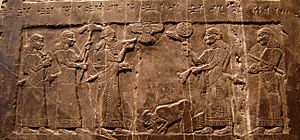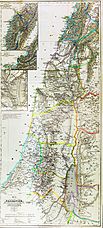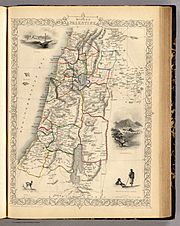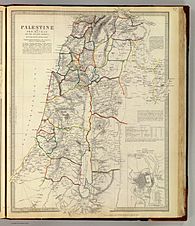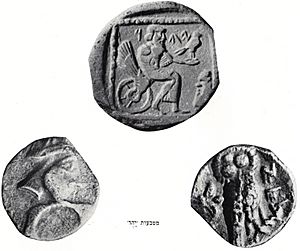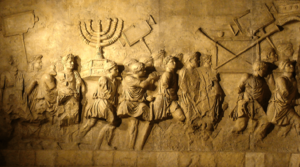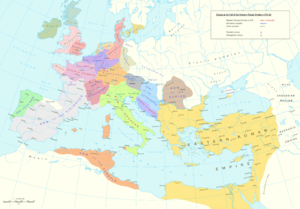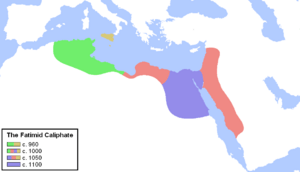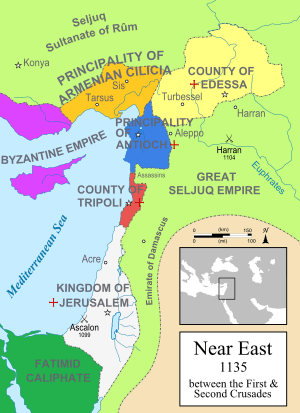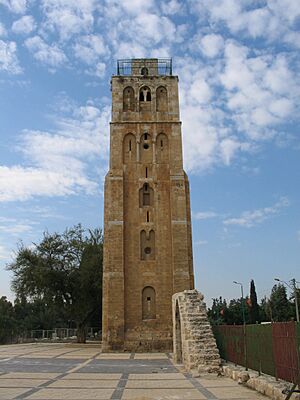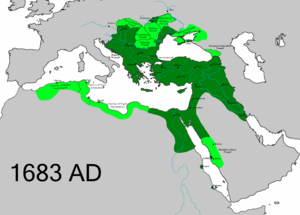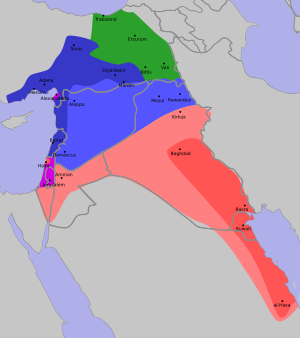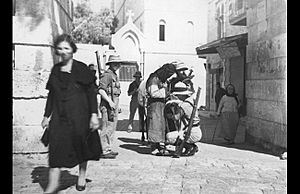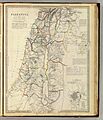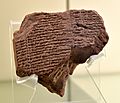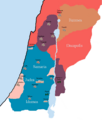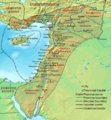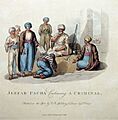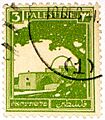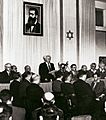History of Palestine facts for kids
The history of Palestine is the story of the land between the Mediterranean Sea and the Jordan River. This area is also known as the Land of Israel or the Holy Land. Today, it is where Israel and Palestine are located.
Palestine has always been a very important place. It sits between three continents, making it a busy crossroads for trade, different cultures, and politics. It's also the birthplace of major religions like Judaism and Christianity. Many powerful kingdoms and empires have ruled this land over thousands of years. These include Ancient Egypt, Ancient Israel and Judah, the Persian Empire, Alexander the Great and his generals, the Hasmoneans, the Roman Empire, various Muslim Caliphates, and the Crusaders. More recently, the Ottoman Empire ruled, followed by the United Kingdom. Since 1948, the land has been divided into Israel, the West Bank, and the Gaza Strip.
Contents
- Early History
- Greek and Roman Periods
- Byzantine Period
- Early Muslim Period
- Crusader Period
- Ayyubid and Mamluk Periods
- Ottoman Period
- British Mandate Period
- UN Partition and 1948 War
- Israel and the Occupied Palestinian Territories
- Images for kids
- Graphical overview of Palestine's historical sovereign powers
- See also
Early History
Palestine is one of the oldest places where humans lived and started farming. Early communities here developed into some of the world's first civilizations.
Ancient Times
In the Bronze Age (around 3000-1500 BCE), the Canaanites built independent city-states. These cities had strong walls and traded with powerful neighbors like Egypt and Syria. Around 2300 BCE, parts of this Canaanite civilization were destroyed, and new groups of nomads settled in the hills.
During the Middle Bronze Age (2200-1500 BCE), Canaan was influenced by many cultures. Trade was important, and people developed new tools and farming methods. Later, from about 1550-1400 BCE, the Canaanite city-states became part of the New Kingdom of Egypt. Egyptian pharaohs like Seti I controlled the area.
Around 1200 BCE, the region faced big changes. The Egyptians left, and new groups arrived. The Israelites settled in the central highlands, and the Philistines settled along the southern coast. The Philistines brought new ideas like iron weapons and chariots.
Kingdoms of Israel and Judah
By the 10th and 9th centuries BCE, two related kingdoms formed: Israel in the north and Judah in the south. Israel grew into a powerful kingdom. The people spoke Hebrew.
These kingdoms often fought with their neighbors. In the 9th century BCE, Israel's King Ahab helped lead an army that stopped an invasion by the Assyrian King Shalmaneser III. Later, King Jehu of Israel had to pay tribute to Assyria.
Assyrian and Babylonian Rule
The Assyrians were very powerful. Starting in 734 BCE, they conquered Palestine. They destroyed kingdoms and moved many people to other lands. The Kingdom of Israel was completely destroyed in 720 BCE. Many Israelites moved to Judah in the south.
Later, the Babylonians became powerful. In 605 BCE, the Babylonian King Nebuchadnezzar defeated the Egyptians. He then destroyed Philistine cities like Ashdod and Gaza. In 587 BCE, Nebuchadnezzar attacked and destroyed Jerusalem, ending the Kingdom of Judah. Many Jewish people were forced to live in Babylon. This event is known as the Babylonian captivity.
Persian Rule
Around 539 BCE, the Persian Empire conquered Babylon. The Persians allowed the Jewish people to return to Jerusalem and rebuild their Temple. This area became a Jewish province called Yehud Medinata. During this time, the Jewish religion became strictly monotheistic, meaning people believed in only one God.
Other groups also lived in Palestine. The Samaritans, who also worshipped one God, lived in the Samaria region. The Edomites lived in the southern parts of Judea. The Phoenicians controlled the coastal areas.
Greek culture also became popular during this time. Greek coins were used, and Greek goods were traded.
Greek and Roman Periods
Alexander the Great and His Successors
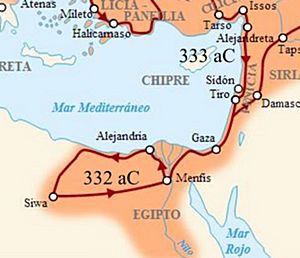
In the late 330s BCE, Alexander the Great conquered Palestine easily on his way to Egypt. After Alexander died, his generals, called the Diadochi, fought over his empire. Palestine was often a battleground between the Ptolemies (who ruled Egypt) and the Seleucids (who ruled Syria). Eventually, the Seleucids took control of Palestine around 200 BCE.
The Greeks brought their language, culture, and way of life to Palestine. This process was called hellenization. Many Greek-style cities were built or rebuilt, which helped the economy.
Hasmonean Kingdom
Around 167 BCE, the Seleucid king Antiochus IV tried to force Greek religion on the Jews. He outlawed Jewish practices and dedicated the Jewish Temple to a Greek god. This led to the Maccabean Revolt, led by Judas Maccabeus and his family, the Hasmoneans.
The Jewish rebels fought against the Seleucids and eventually gained independence around 140 BCE. The Hasmoneans then expanded their kingdom, conquering much of Palestine. They even forced some non-Jews to convert to Judaism.
Roman Rule
In 63 BCE, the Roman general Pompey conquered Jerusalem, and Judea became a client state of Rome. This began a long period of Roman rule. The Romans rebuilt many Greek cities that the Hasmoneans had destroyed.
Herod the Great ruled Judea from 37 to 4 BCE. He was known for his huge building projects, like rebuilding the Second Temple in Jerusalem, which became one of the largest buildings in the Roman Empire. He also built the port city of Caesarea Maritima.
However, many Jews saw Herod as a foreign ruler. After he died, there was unrest. In 6 CE, Judea came under direct Roman rule.
Jewish-Roman Wars
Tensions grew between the Jews and the Romans. Many Jews wanted independence. In 66 CE, the First Jewish-Roman War broke out. The Romans crushed the revolt, destroying Jerusalem and the Second Temple in 70 CE. The Jewish historian Josephus wrote that many Jews died or were taken captive.
Jews revolted again in 132 CE, in the Bar Kokhba revolt. This revolt also failed, and the Romans caused massive destruction. As a result, the center of Jewish life in Palestine moved to the Galilee region.
After these revolts, the Romans renamed the province Syria Palaestina. Some historians believe this was to remove the connection between the Jewish people and their homeland.
Byzantine Period
In the 4th century, the Roman Empire became Christian under Emperor Constantine the Great. This greatly changed Palestine. Churches were built on important Christian sites, like the Church of the Holy Sepulchre in Jerusalem (where Jesus was believed to be crucified and buried) and the Church of the Nativity in Bethlehem (where he was believed to be born). Many monasteries were also built.
Palestine became a very important center for Christianity, attracting pilgrims and scholars. The city of Jerusalem became a major Christian center. This was a time of great prosperity and cultural growth for Palestine. Cities grew, and trade flourished.
Jewish communities continued to live in Palestine, especially in the north. However, the Byzantines sometimes discriminated against non-Christians. In the 5th and 6th centuries, the Samaritans rebelled several times, but these revolts were put down.
In the early 7th century, the Byzantine Empire fought a long war with the Persian Empire. The Persians captured Jerusalem in 614 CE, but the Byzantines eventually won it back. This long war weakened both empires, paving the way for a new power.
Early Muslim Period
In the late 6th century, Islam was founded by the prophet Muhammad. His followers, called Muslims, quickly built a large empire. They conquered Palestine between 636 and 640 CE.
Under Muslim rule, society was organized with Arabs at the top. Christians, Jews, and Samaritans were called dhimmis (protected people). They were allowed to practice their religions but had to pay a special tax. Muslims also lifted the Roman ban on Jews living in Jerusalem.
Palestine was divided into military districts. The city of Ramla became an important capital. Palestine was a rich province for the caliphate, known for its trade, farming, and crafts like glassmaking.
Umayyad Caliphate
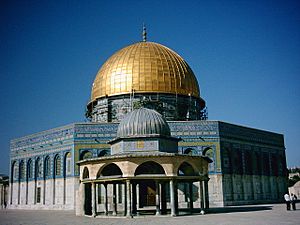
The Umayyads became the ruling family of the caliphate in 661 CE. They moved the capital to Damascus, which made nearby Jerusalem even more important.
The Umayyads built two famous Islamic buildings on the Temple Mount in Jerusalem: the al-Aqsa Mosque and the Dome of the Rock. The Dome of the Rock is the oldest Islamic monument still standing today. It was built where Muslims believe Prophet Muhammad began his journey to heaven.
Throughout this period, there were often conflicts between different Arab tribes, which caused unrest in Palestine.
Abbasid Caliphate
In 750 CE, the Abbasids overthrew the Umayyads and moved the capital to Baghdad. This made Palestine less central to the empire. Rebellions and violence often troubled Abbasid rule in Palestine.
Towards the end of the 9th century, the Abbasids started losing control of their western provinces. Egypt's governor, Ahmad Ibn Tulun, declared independence and took over Syria, including Palestine. The Tulunids were later replaced by the Ikshidids. In 969 CE, the Fatimid Caliphate conquered the region.
Fatimid Caliphate
The Fatimids ruled Palestine for about 60 years, a time of frequent wars and destruction. Bedouin tribes often rebelled and caused much damage.
In 1009 CE, the Fatimid Caliph Al-Hakim bi-Amr Allah ordered the destruction of churches and synagogues, including the Church of the Holy Sepulchre. This angered Christians in Europe. His successor allowed the church to be rebuilt.
In the 11th century, the Seljuk Turks invaded West Asia, including Palestine. Their rule brought more violence and economic hardship. In 1098, the Fatimids recaptured Jerusalem from the Seljuks.
Crusader Period
The Crusades (1095–1291) were military campaigns by European Christians to take control of the Holy Land from Muslims. Many Europeans felt a special connection to Palestine because of its religious importance. When the Byzantines asked for help against the Muslims, the Europeans launched the First Crusade.
The First Crusade captured much of the eastern Mediterranean coast. The Kingdom of Jerusalem was founded in 1100, covering most of Palestine. However, the Crusaders and Muslims continued to fight for control.
In 1187, the Egyptian-based Ayyubid dynasty captured Jerusalem from the Crusaders. Later, a new crusade helped the Crusaders regain some coastal areas, but not Jerusalem. A treaty was signed, allowing Christian pilgrims to visit the Church of the Holy Sepulchre.
In 1244, Jerusalem was captured by Khwarizmians, who destroyed churches and killed Christians. This led to a major battle where the Crusaders suffered a huge defeat. In 1291, the Mamluks destroyed Acre, the last Crusader stronghold, ending Crusader rule in Palestine.
During this period, military orders like the Knights Templar and Knights Hospitaller were formed. These knights combined religious discipline with fighting skills to defend the Crusader states. Many castles and fortified villages were built.
Ayyubid and Mamluk Periods
After the Crusaders, the Ayyubid dynasty allowed Jewish and Orthodox Christian people to settle in the region. The Dome of the Rock was again used as an Islamic place of worship.
The Mamluks took control of Egypt and then Palestine in the mid-13th century. Palestine and Syria became a key battleground against the expanding Mongol Empire. In 1260, the Mamluks decisively defeated the Mongols at the Battle of Ain Jalut in the Jezreel Valley. This battle stopped the Mongol advance.
To prevent future Crusader attacks from the sea, the Mamluks destroyed many coastal cities and ports. This caused these areas to remain sparsely populated for centuries. Palestine was divided into three districts with capitals in Jerusalem, Gaza, and Safed. The Mamluks also built a "postal road" with inns for travelers and renovated mosques.
Ottoman Period
In 1516, the Ottoman Turks conquered Palestine from the Mamluks. The conquest was quick, with only small battles. The Ottomans kept a similar administrative system. Palestine was part of the larger province of Damascus and divided into districts like Safad, Nablus, Jerusalem, Lajjun, and Gaza.
The Ottomans ruled centrally from Istanbul for a long time. Most people lived in villages. The largest cities were Gaza, Safad, and Jerusalem. The land was managed through a system of fiefs and trusts.
The name "Palestine" was not an official administrative name under the Ottomans, but it was still commonly used by people and in some official documents.
Decentralization and Local Rule
Over time, direct Ottoman rule weakened. New local ruling families emerged in Palestine, like the Ridwan, Farrukh, and Turabay dynasties. These families often intermarried and cooperated, gaining much power.
In the 18th century, a local leader named Zahir al-Umar became very powerful in northern Palestine. He controlled trade and built up the port city of Acre. He encouraged people to move to Palestine, which helped the economy grow. Zahir even founded modern-day Haifa. However, he was eventually defeated and killed by Ottoman forces in 1775.
After Zahir, Jazzar Pasha took control of Acre. He was a strong ruler who further fortified Acre. He fought against Napoleon of France, who invaded Palestine in 1799. Napoleon failed to capture Acre and had to retreat.
Egyptian Rule and Ottoman Restoration
In 1831, Muhammad Ali of Egypt sent his army, led by his son Ibrahim Pasha, to conquer Ottoman Syria, including Palestine. Egyptian rule brought big changes, including new taxes and forced military service for peasants. These policies were very unpopular and led to the Peasants' Revolt in 1834. The Egyptians crushed the revolt, but their rule was short-lived.
In 1841, Britain helped the Ottomans regain control of Palestine. Britain and other European powers gained more rights in the Ottoman Empire, which meant they had their own courts and schools.
In the late 19th century, the Ottomans reorganized Palestine. The northern part became part of the province of Beirut, while the southern part, including Jerusalem, became a special district directly under Istanbul.
Rise of Zionism
In the late 19th century, Zionism, a movement to create a Jewish state in Palestine, began in Europe. This led to waves of Jewish immigration to Palestine. The "First Aliyah" (1881-1903) brought about 25,000 Jews, mostly from Eastern Europe. The "Second Aliyah" (1904-1914) brought another 35,000 Jews.
Local Arab leaders in Jerusalem sent petitions to the Ottoman government, asking them to stop Jewish immigration and land sales to Jews.
British Mandate Period
During World War I, the Ottoman Empire sided with Germany and was defeated by the British. In 1917, British forces captured Jerusalem.
After the war, the League of Nations gave Britain a "mandate" to govern Palestine between 1920 and 1948. This was called the "British Mandate." The mandate's goal was to help establish a "national home for the Jewish people" in Palestine, while also protecting the rights of existing non-Jewish communities.
However, not everyone was happy. Some Arabs felt Britain had broken promises of Arab independence. They wanted Palestine to be united with Syria. In 1920, violent Arab riots against Jews occurred in Jerusalem.
In 1921, Britain divided the Mandate territory. The area east of the Jordan River became Transjordan, which was excluded from the plans for a Jewish National Home. The area west of the Jordan River remained Palestine.
Governance and Demographics
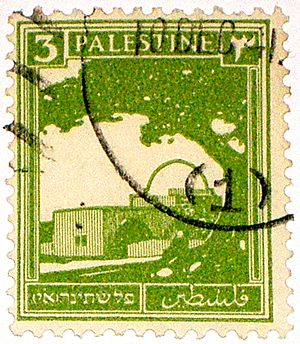
The most important Palestinian leader during this time was Haj Amin al-Husayni, who was appointed "Grand Mufti of Palestine." He led the Palestinian struggle for independence. The British also created the Muslim Higher Council to provide religious leadership, which caused rivalries among Palestinian families.
The British allowed a lot of Jewish immigration to Palestine, which caused a big change in the population. In 1922, Arabs made up 89% of the population and Jews 11%. By 1947, the Jewish population had grown to 31%.
Jewish immigration increased a lot in the 1930s, especially after Adolf Hitler came to power in Germany. However, during World War II, Britain reduced Jewish immigration, leading to many Jews fleeing Nazi persecution being held in detention camps.
The 1936–1939 Revolt
A major revolt, known as the Great Palestinian Revolt, took place from 1936 to 1939. Palestinians were angry about British rule and Jewish settlement. It started as a general strike and became an armed uprising.
The British responded harshly, using many troops and punishments like house demolitions. An estimated 10% of adult Palestinian men were killed, wounded, or imprisoned. The revolt failed to achieve its goals and left the Palestinians without strong local leadership.
During the revolt, the Haganah, a Jewish defense organization, helped the British. Another Jewish group, the Irgun, used violent attacks against Arabs and British forces.
End of the British Mandate
After World War II, Britain struggled to control Palestine. The cost of keeping a large army there was too high, and Jewish paramilitary groups like the Haganah, Irgun, and Lehi launched attacks on British forces.
In early 1947, the British government announced it would end its rule and asked the United Nations to decide Palestine's future.
UN Partition and 1948 War
On November 29, 1947, the United Nations voted to partition Palestine into two states: one Arab and one Jewish. Jerusalem was to be a special international zone. Jewish leaders accepted the plan, but Palestinian Arab leaders and Arab states rejected it.
Immediately, fighting broke out. This led to a civil war. Many Arab Palestinians fled or were driven from their homes.
On May 14, 1948, David Ben-Gurion declared the independence of the State of Israel. Neighboring Arab countries then invaded Palestine. Israel won the war, conquering more territory than the UN plan had suggested. During the war, about 700,000 Palestinians became refugees. This event is known as the Nakba (Catastrophe) to Palestinians.
Division of the Land
After the 1948 war, the former British Mandate territory was divided. Israel controlled about 78% of the land. Jordan took control of the West Bank (including East Jerusalem), and Egypt occupied the Gaza Strip. Jerusalem was divided between Jordan and Israel.
Jordan later officially annexed the West Bank. In Gaza, the All-Palestine Government was set up by the Arab League, but it had limited power and was under Egyptian protection.
Israel and the Occupied Palestinian Territories
In June 1967, the Six-Day War broke out. Israel captured the West Bank (including East Jerusalem) from Jordan and the Gaza Strip from Egypt. Israel also took the Golan Heights from Syria and the Sinai Peninsula from Egypt. East Jerusalem was later annexed by Israel, though this is not widely recognized internationally. Israel also began building settlements in the occupied territories.
The United Nations Security Council passed Resolution 242, which called for Israel to withdraw from the lands it occupied in 1967 in exchange for peace. Palestinians continued to seek self-determination.
In the Yom Kippur War of 1973, Egypt and Syria tried to regain lost territories. After a ceasefire, Egypt and Israel signed a peace treaty, and Israel returned the Sinai Peninsula to Egypt.
Peace Efforts and Palestinian Authority
From 1987 to 1993, the First Palestinian Intifada, an uprising against Israel, took place. In 1993, the Oslo Accords were signed between Israel and the Palestine Liberation Organisation (PLO). This agreement gave Palestinians limited self-rule in parts of Gaza and the West Bank through the Palestinian National Authority (PA).
However, peace efforts stalled. In 2000, the Second Intifada (Al-Aqsa Intifada) began, marked by violence from both sides.
Gaza-West Bank Split
In 2006, the Islamist group Hamas won Palestinian elections. This led to a conflict with Fatah, the party that controlled the PA. In 2007, Hamas took control of the Gaza Strip, while Fatah remained in control of the West Bank. This split the Palestinian territories into two separate governments.
Observer Status at the UN
In 2011, Palestinian President Mahmoud Abbas applied for Palestine to become a full member state of the United Nations. This effort was supported by many countries. In November 2012, the UN General Assembly voted to upgrade Palestine's status to a "non-member observer state." This was seen as a step towards international recognition of a Palestinian state.
Images for kids
-
Maps of Ottoman Palestine showing the Kaza subdivisions.
-
Maps of Ottoman Palestine showing the Kaza subdivisions.
-
Maps of Ottoman Palestine showing the Kaza subdivisions.
-
A dwelling unearthed at Tell es-Sultan, Jericho
-
Map of the Ancient Near East during the Amarna Period, showing the great powers of the day: Egypt (orange), Hatti (blue), the Kassite kingdom of Babylon (black), Middle Assyrian Empire (yellow), and Mitanni (brown). The extent of the Achaean/Mycenaean civilization is shown in purple.
-
Philistine captives of the Egyptians, from a graphic wall relief at Medinet Habu, in about 1185–52 BCE, during the reign of Ramesses III
-
The Lachish reliefs, found in Nineveh, commemorate the story of the Assyrian victory over the kingdom of Judah during the siege of Lachish in 701 BCE
-
Holyland Model of Jerusalem, depicting the city during the late Second Temple period. First created in 1966, it is continuously updated according to advancing archaeological knowledge. Herod's Temple appears in the middle
-
Division of Herod's kingdom: Herod Archelaus' territory in blue, Herod Antipas' in purple, Philip the Tetrarch's in brown, and Salome I's in pink. Province of Syria in red.
-
The Dome of the Rock
-
The Kingdom of Jerusalem and the Crusader states with their strongholds in the Holy Land at their height, between the First and the Second Crusade (1135)
-
Belvoir Castle, also known as the Kochav HaYarden, built by the Knights Hospitaller starting in 1168
-
Palestine and Transjordan were incorporated (under different legal and administrative arrangements) into the "Mandate for Palestine and Transjordan Memorandum" issued by the League of Nations to Great Britain on 29 September 1923
-
Rachel's Tomb on a 1927 British Mandate stamp. "Palestine" is shown in English, Arabic (فلسطين), and Hebrew, the latter includes the acronym א״י for Eretz Yisrael
-
Jewish Brigade headquarters under both Union Flag and Jewish flag
-
David Ben-Gurion proclaiming independence beneath a large portrait of Theodor Herzl, founder of modern Zionism
-
The region today: Israel, the West Bank, the Gaza Strip and the Golan Heights
Graphical overview of Palestine's historical sovereign powers
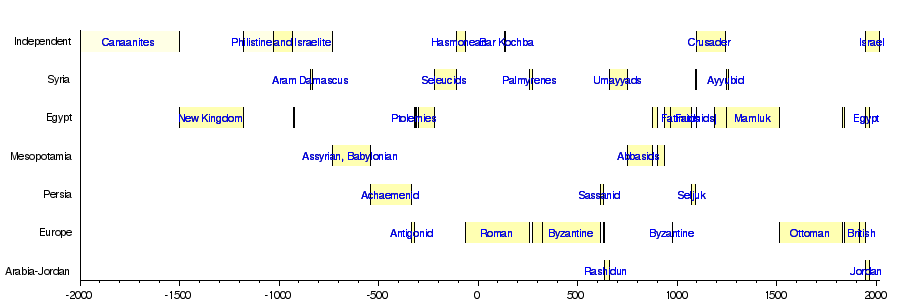
See also
 In Spanish: Historia de Palestina para niños
In Spanish: Historia de Palestina para niños
- Architecture of Palestine
- Demographic history of Palestine (region)
- History of ancient Israel and Judah
- History of Israel
- History of the ancient Levant
- History of the Middle East
- Levantine archaeology (including useful periodisation)
- Shaam
- Timeline of Jerusalem
- Timeline of the name Palestine
- Timeline of the Palestine region


